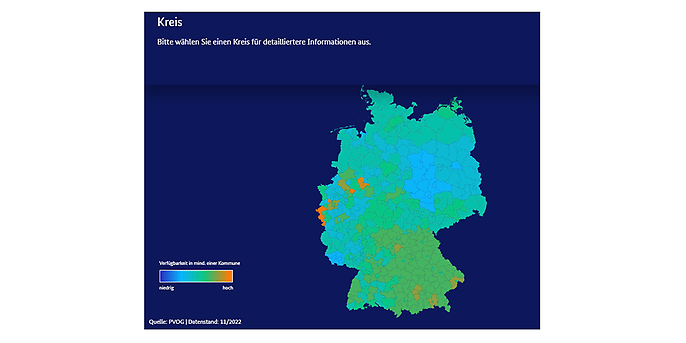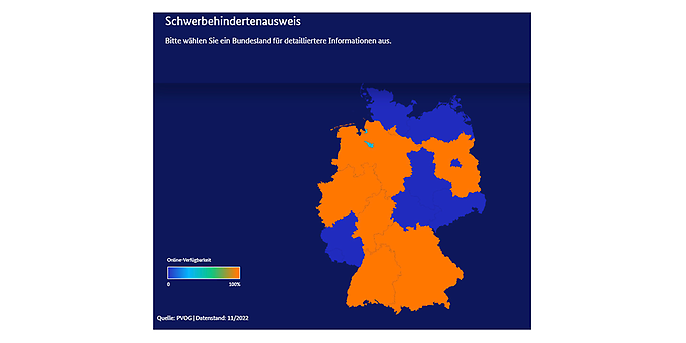18. January 2023 By Vanessa Schönen
What actually became of the German Online Access Act?
The digitalisation of the German healthcare system continues to be an ongoing issue. The German Online Access Act (Onlinezugangsgesetz, OZG), which was adopted in 2017, was intended to provide support for digitalisation and make a number of the administrative services provided by the German federal government and the German states electronically accessible by the end of 2022 – including in the healthcare system.
The objectives were:
- User-friendliness for citizens and employees – processes should be simplified and adapted to the needs of the target groups
- Time saving – digitalisation should make administration faster and more reliable
- Quality and security – the administration of the federal, state and local governments should be digitalised as a collective
- Efficiency – standardisation and having a common base component should create a sustainable and efficient IT structure
What can we expect in 2023?
The implementation of the German Online Access Act was focused on users, which means that only administrative services that have a direct impact on citizens and businesses were digitalised. The Online Access Act implementation catalogue is what this implementation is based on. The catalogue comprises 575 services that are divided into 14 subject areas and must be offered online. 115 of the 575 services were prioritised during implementation.
The subject area of health was developed under the leadership of the Federal State of Lower Saxony with the support of the German Federal Ministry of Health (Bundesministerium für Gesundheit, BMG) and includes about 60 administrative services. These administrative services deal with areas such as staying healthy, illness, care provision, disability and death, which are incredibly complex topics given they involve both handling sensitive patient data and dealing with emotional and ethical challenges.
A lot has happened since 2017, but nowhere near what was planned. This brings us to the question of which administrative services in the healthcare system will be available digitally from 2023 – and there is no easy answer. The last report on the current development status that could be found online was from back in 2020, and the Online Access Act had not been seen in the news since then. But then, on 14 December 2022 – the day on which the term of the Online Access Act ended, the German Federal Ministry of the Interior and Community (Bundesministerium des Innern und für Heimat, BMI) published a report outlining what the Online Access Act had achieved in the past five years.
It describes that to a large extent the interoperable infrastructures were created by the Online Access Act. By the time the report was published, 87 of the 115 services prioritised in the Online Access Act were offered online, and that number was expected to rise by the end of 2022. However, the €3 billion worth of funding allocated from 2020 to 2022 was only partially spent; either less money was needed or some objectives for which the money was intended have not yet been tackled.
In addition, the Federal Portal was opened to the public in 2021. This portal is where people can access all the services of the Online Access Act. Accessing the ‘personal matters’ section will give you the option to view the ‘health’ services section, where you can filter by the categories ‘staying healthy’, ‘illness’, ‘disability’ and ‘care provision’. As of 20 December 2022, there are about 300 entries in the Federal Portal under ‘health’ in the ‘personal matters’ section, of which about 350 entries are assigned to the topic of illness, 683 to the topic of disability and around 100 entries are assigned to the topic of care provision. These figures are based on the individual services provided by the municipalities in the respective states, meaning that one Online Access Act service does not equal one entry. The easiest way to explain this connection is to search for ‘part-time during parental leave’, as there seems to be a separate entry for each federal state and many other results that have ‘part-time’ or ‘parental leave’ in the title.
The implementation can be tracked in the OZG Dashboard (only German), where you can view the development statuses, divided into federal government, federal states and districts. But it is clear to see that Germany is something of a patchwork in terms of implementation:

Figure 1: View of the OZG Dashboard at district level
I have tested two functions for myself
I can only select sickness benefit for those with health insurance in North Rhine-Westphalia in the administrative district of Münster, where it can only be applied for in the municipality of Wadersloh. The Federal Portal consequently redirects me to the website of the municipality of Wadersloh, but I cannot find an online application to apply for sickness benefit there. I am only shown a reference text on social welfare and a link to who I can contact in the municipal administration. Personally, this does not do me much good if I wanted to apply for sickness benefit online, as I now have to go to the municipality after all.

Figure 2: OZG Dashboard – service to apply for a disabled pass
This situation also becomes clear with the service of being able to apply for a disabled pass online. In the federal states in orange in the diagram, I can apply for it in all districts, in the dark blue federal states I cannot apply for it in any of the districts. The state of Bremen offers it in one of two districts.
I save myself the long search of going through 958 entries for the disabled pass, as I look for it directly using the keyword search. After selecting the federal state of North Rhine-Westphalia and the administrative district of Detmold, I can then select the districts of Gütersloh and Lippe. For both, I get a link to ELSA.NRW – application according to the German Disabilities Act (Schwerbehindertenrecht). I can now enter all the important data here and send the application. At this point, I am happy to be able to fill in an online form because that is exactly what I expected to be able to do.
Consequently, the services offered are highly dependent on the respective federal state and administrative district. For users, it means that they either know exactly what they are looking for and where they will find it, or that they have to search for a long time until they find it. The keyword search allows you to narrow down the possible search results. A filter function that filters according to administrative regions or counties would be much more user-friendly here, especially since the portal was designed to be user-centric.
Personal conclusion
The German Federal Ministry of Health’s website has a quote from Dr Markus Richter, State Secretary in the German Federal Ministry of the Interior and Community and German Federal Government Commissioner for Information Technology, which I find very appropriate: ‘The Online Access Act marked the start of a sustainable transformation for administration.’
I can see the Online Access Act as the start of a sustainable and digital transformation for administration, but it still needs some updates to create a continuous improvement process. Similar to hardware at home, which needs continuous updates, the digitalisation of administration needs them as well. In addition, in my view, there is a need to provide users with more active education as to which functions are available online and could possibly replace their next appointment with the municipality or city.
In recent years in particular, which were shaped by crises, administrative services were quickly implemented within the framework of the Online Access Act, for example to make services for infection control available online. This proved that digitalisation can be the fastest and safest way to find a solution in such cases. The initial set of functions available in the Federal Portal are adequate for me as a user, but the portal’s performance in terms of user-friendliness leaves a lot to be desired and leaves room for improvement. I would like to find just one single entry for each service in the Federal Portal, which I can then filter according to my wishes, state, district, municipality.
Nevertheless, in my opinion, we are on the right path here and I am happy that we will continue to follow it this year. On 14 December 2022, the German Federal Ministry of Health announced that there will be a follow-up law to the Online Access Act in 2023. The Online Access Act 2.0 should consolidate the structures created so far and offer the chance to successfully complete many more digitalisation projects. It is still an exciting topic because the modernisation of administration is underway and offers users a host of new possibilities.
You will find more exciting topics from the adesso world in our latest blog posts.

